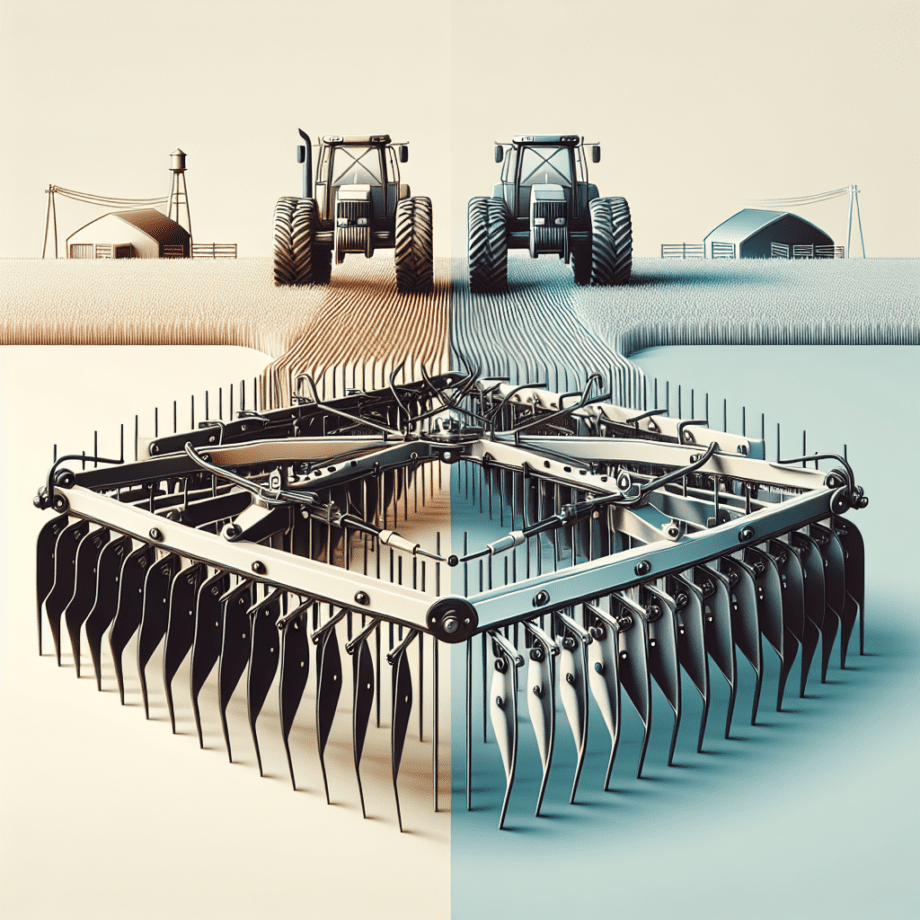Choosing the right type of harrow for your farm can significantly impact soil preparation, crop yield, and overall farm efficiency. Two of the most commonly used harrows are disc harrows and tine harrows. Each has its own set of advantages and disadvantages, making it crucial to understand their functionalities and applications to make an informed decision.
Understanding Disc Harrows
Disc harrows are agricultural implements that use a series of concave metal discs to till the soil. These discs are mounted on a frame and can be adjusted to various angles to achieve different soil penetration levels. Disc harrows are particularly effective in breaking up clods, incorporating crop residues, and preparing seedbeds.
Advantages of Disc Harrows
- Effective Soil Penetration: The concave discs can penetrate hard and compacted soils, making them ideal for initial soil preparation.
- Residue Management: Disc harrows are excellent at chopping and incorporating crop residues into the soil, which can improve soil organic matter and fertility.
- Versatility: They can be used for a variety of tasks, including primary tillage, seedbed preparation, and weed control.
- Adjustability: The angle of the discs can be adjusted to control the depth and aggressiveness of the tillage.
Disadvantages of Disc Harrows
- Soil Compaction: While effective at breaking up soil, disc harrows can also cause soil compaction, particularly in wet conditions.
- High Power Requirement: They require more horsepower to operate, which can increase fuel consumption and operational costs.
- Maintenance: The discs and bearings require regular maintenance to ensure optimal performance and longevity.
Understanding Tine Harrows
Tine harrows, also known as spring-tooth harrows, use a series of flexible tines to till the soil. These tines are mounted on a frame and can be adjusted for different soil conditions and tillage depths. Tine harrows are particularly effective for secondary tillage, seedbed preparation, and weed control.
Advantages of Tine Harrows
- Gentle Soil Treatment: Tine harrows are less aggressive than disc harrows, making them ideal for light soil cultivation and seedbed preparation.
- Weed Control: The flexible tines can uproot weeds without causing significant soil disturbance, which can help preserve soil structure.
- Lower Power Requirement: They require less horsepower to operate, making them more fuel-efficient and cost-effective.
- Versatility: Tine harrows can be used for a variety of tasks, including aerating the soil, breaking up crusts, and incorporating fertilizers.
Disadvantages of Tine Harrows
- Limited Soil Penetration: Tine harrows are less effective at penetrating hard and compacted soils, making them less suitable for primary tillage.
- Residue Management: They are not as effective at chopping and incorporating crop residues as disc harrows.
- Maintenance: The tines can wear out or break over time, requiring regular inspection and replacement.
Factors to Consider When Choosing Between Disc Harrows and Tine Harrows
When deciding between disc harrows and tine harrows, several factors should be considered to ensure you select the right tool for your farm’s specific needs.
Soil Type and Condition
The type and condition of your soil play a significant role in determining which harrow is best suited for your farm. Disc harrows are more effective in heavy, compacted soils, while tine harrows are better suited for lighter, well-drained soils.
Crop Residue Management
If your farm produces a significant amount of crop residue, a disc harrow may be more effective at chopping and incorporating the residue into the soil. On the other hand, if residue management is not a primary concern, a tine harrow may be sufficient.
Power Availability
Disc harrows require more horsepower to operate, which can increase fuel consumption and operational costs. If your farm has limited power availability, a tine harrow may be a more cost-effective option.
Desired Tillage Depth
Disc harrows can achieve greater soil penetration, making them suitable for primary tillage. Tine harrows, however, are better suited for shallow tillage and seedbed preparation.
Maintenance and Durability
Both types of harrows require regular maintenance, but the specific maintenance needs can vary. Disc harrows require more frequent inspection and lubrication of discs and bearings, while tine harrows require regular inspection and replacement of tines.
Conclusion
Choosing between disc harrows and tine harrows depends on various factors, including soil type, crop residue management, power availability, desired tillage depth, and maintenance requirements. By carefully considering these factors, you can select the right harrow for your farm, ultimately improving soil preparation, crop yield, and overall farm efficiency.
Both disc harrows and tine harrows have their own set of advantages and disadvantages, making them suitable for different farming applications. Understanding their functionalities and applications will help you make an informed decision, ensuring that you choose the right tool for your specific needs.
